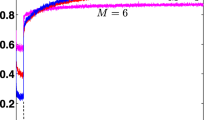Abstract
This paper investigates the performance-complexity tradeoff of the wide-sense likelihood ascent search (WSLAS) detectors in large multicode sparse-sequence CDMA. It is illustrated that when each sequence has sparsely only 16 nonzero chips, in a channel load up to 1.05 bits/s/Hz and a broad SNR region, the linearly complex WSLAS detectors can achieve the benchmark optimum BER while the complexity is significantly reduced from 0.5 times bit number to a constant less than 30 additions per bit by the sequence sparsity. The evaluation result of multiuse efficiency also shows that the sparse sequences of 16 nonzero chips can already provide a sufficient degree of freedom.
Similar content being viewed by others
References
Guo, D., & Verdú, S. (2002). Multiuser detection and statistical mechanics. In V. Bhargava, H. V. Poor, V. Tarokh, & S. Yoon, (Eds.), Communications, information, and network security (Chap. 13), 229–277. Norwell, MA: Kluwer Academic.
Tanaka T. (2002) A statistical-mechanics approach to large-system analysis of CDMA multiuser detectors. IEEE Transactions on Information Theory 48: 2888–2910
Tanaka T., Okada M. (2005) Approximate belief propagation, density evolution, and statistical neurodynamics for CDMA multiuser detection. IEEE Transactions on Information Theory 51(2): 700–706
Montanari, A., & Tse, D. (2006). Analysis of belief propagation for non-linear problems: The example of CDMA (or: How to prove Tanaka’s formula). In Proceedings of IEEE information theory workshop, Punta del Este, Uruguay.
Yoshida, M., & Tanaka, T. (2008). Analysis of sparsely-spread CDMA via statistical mechanics. In Proceedings of IEEE international symposium information theory, pp. 2378–2382, Seattle, WA, USA 2008.
Raymond J., Saad D. (2007) Sparsely spread CDMA—a statistical mechanics-based analysis. Journal of Physics A: Mathematical and Theoretical 40(41): 12315–12333
Guo D., Wang C.-C. (2008) Multiuser detection of sparsely spread CDMA. IEEE Journal on Selected Areas in Communication 26(3): 421–431
Raymond, J. (2009). Optimal sparse CDMA detection at high load. In Proceedings of 7th international symposium on modeling and optimization in mobile, ad Hoc, & wireless networks, WiOPT 2009, pp. 1–5, Hong Kong, China.
Takeuchi, K., Tanaka, T., & Kawabata, T. (2012). Performance improvement of iterative multiuser detection for large sparsely-spread CDMA systems by spatial coupling. Submitted to IEEE Transactions on Information Theory (arXiv:1206.5919).
Sun Y. (2009) A family of likelihood ascent search multiuser detectors: approaching optimum performance via random multicodes with linear complexity. IEEE Transactions on Communications 57(8): 2215–2220
Sun Y. (2009) A family of likelihood ascent search multiuser detectors: An upper bound of bit error rate and a lower bound of asymptotic multiuser efficiency. IEEE Transactions on Communications 57(6): 1743–1752
Tse D., Viswanath P. (2005) Fundamentals of wireless communication. Cambridge University Press, Cambridge
Author information
Authors and Affiliations
Corresponding author
Rights and permissions
About this article
Cite this article
Sun, Y., Xiao, J. Multicode Sparse-Sequence CDMA: Approach to Optimum Performance by Linearly Complex WSLAS Detectors. Wireless Pers Commun 71, 1049–1056 (2013). https://doi.org/10.1007/s11277-012-0859-0
Published:
Issue Date:
DOI: https://doi.org/10.1007/s11277-012-0859-0




